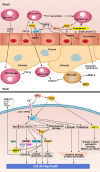Hemorrhagic Transformation After Tissue Plasminogen Activator Treatment in Acute Ischemic Stroke
- PMID: 33125600
- PMCID: PMC11441267
- DOI: 10.1007/s10571-020-00985-1
Hemorrhagic Transformation After Tissue Plasminogen Activator Treatment in Acute Ischemic Stroke
Abstract
Hemorrhagic transformation (HT) is a common complication after thrombolysis with recombinant tissue-type plasminogen activator (rt-PA) in ischemic stroke. In this article, recent research progress of HT in vivo and in vitro studies was reviewed. We have discussed new potential mechanisms and possible experimental models of HT development, as well as possible biomarkers and treatment methods. Meanwhile, we compared and analyzed rodent models, large animal models and in vitro BBB models of HT, and the limitations of these models were discussed. The molecular mechanism of HT was investigated in terms of BBB disruption, rt-PA neurotoxicity and the effect of neuroinflammation, matrix metalloproteinases, reactive oxygen species. The clinical features to predict HT were represented including blood biomarkers and clinical factors. Recent progress in neuroprotective strategies to improve HT after stroke treated with rt-PA is outlined. Further efforts need to be made to reduce the risk of HT after rt-PA therapy and improve the clinical prognosis of patients with ischemic stroke.
Keywords: Blood; Brain barrier; Hemorrhagic transformation; Ischemic stroke; Tissue plasminogen activator.
© 2020. Springer Science+Business Media, LLC, part of Springer Nature.
Conflict of interest statement
The authors declare that there is no conflict of interest for the publication of this article.
Figures



Similar articles
-
Neuroinflammation in hemorrhagic transformation after tissue plasminogen activator thrombolysis: Potential mechanisms, targets, therapeutic drugs and biomarkers.Int Immunopharmacol. 2021 Jan;90:107216. doi: 10.1016/j.intimp.2020.107216. Epub 2020 Dec 6. Int Immunopharmacol. 2021. PMID: 33296780 Review.
-
Hemorrhagic Transformation after Tissue Plasminogen Activator Reperfusion Therapy for Ischemic Stroke: Mechanisms, Models, and Biomarkers.Mol Neurobiol. 2015 Dec;52(3):1572-1579. doi: 10.1007/s12035-014-8952-x. Epub 2014 Nov 4. Mol Neurobiol. 2015. PMID: 25367883 Free PMC article. Review.
-
Application of Neuroimaging for the Prediction of Hemorrhagic Transformation after Intravenous Thrombolysis in Acute Ischemic Stroke.Cerebrovasc Dis. 2023;52(1):1-10. doi: 10.1159/000524749. Epub 2022 Jun 3. Cerebrovasc Dis. 2023. PMID: 35661647 Review.
-
GAS6/Axl Signaling Modulates Blood-Brain Barrier Function Following Intravenous Thrombolysis in Acute Ischemic Stroke.Front Immunol. 2021 Oct 18;12:742359. doi: 10.3389/fimmu.2021.742359. eCollection 2021. Front Immunol. 2021. PMID: 34733281 Free PMC article.
-
Effect of intravenous thrombolysis in acute ischemic stroke patients with cerebral microbleeds and analysis of risk factors for hemorrhagic transformation.Eur Rev Med Pharmacol Sci. 2022 Feb;26(3):779-786. doi: 10.26355/eurrev_202202_27986. Eur Rev Med Pharmacol Sci. 2022. PMID: 35179744
Cited by
-
Outcomes and risk factors for functional prognosis at 3 months after intravenous thrombolysis with r-tPA in patients with acute ischemic stroke: a retrospective cohort study.Thromb J. 2025 Mar 10;23(1):21. doi: 10.1186/s12959-025-00704-0. Thromb J. 2025. PMID: 40065429 Free PMC article.
-
NLRP3 Inhibition Reduces rt-PA Induced Endothelial Dysfunction under Ischemic Conditions.Biomedicines. 2022 Mar 24;10(4):762. doi: 10.3390/biomedicines10040762. Biomedicines. 2022. PMID: 35453512 Free PMC article.
-
Mitophagy, a Form of Selective Autophagy, Plays an Essential Role in Mitochondrial Dynamics of Parkinson's Disease.Cell Mol Neurobiol. 2022 Jul;42(5):1321-1339. doi: 10.1007/s10571-021-01039-w. Epub 2021 Feb 2. Cell Mol Neurobiol. 2022. PMID: 33528716 Free PMC article. Review.
-
Levels of Fibrin Degradation Products at Admission With Acute Ischemic Stroke Correlate With the NIH Stroke Scale Score 1 h After Intravenous Thrombolysis.Front Neurol. 2021 May 28;12:651867. doi: 10.3389/fneur.2021.651867. eCollection 2021. Front Neurol. 2021. PMID: 34122300 Free PMC article.
-
Hemorrhage-Induced Sphingosine Kinase 1 Contributes to Ferroptosis-Mediated Secondary Brain Injury in Intracerebral Hemorrhage.Mol Neurobiol. 2022 Mar;59(3):1381-1397. doi: 10.1007/s12035-021-02605-5. Epub 2022 Jan 7. Mol Neurobiol. 2022. PMID: 34993846
References
-
- Abbott NJ, Patabendige AA, Dolman DE, Yusof SR, Begley DJ (2010) Structure and function of the blood-brain barrier. Neurobiol Dis 37(1):13–25. 10.1016/j.nbd.2009.07.030 - PubMed
-
- Abeysinghe H, Roulston CL (2018) A Complete guide to using the endothelin-1 model of Stroke in conscious rats for acute and long-term recovery studies. Methods Mol Biol 1717:115–133. 10.1007/978-1-4939-7526-6_10 - PubMed
-
- Abumiya T, Yokota C, Kuge Y, Minematsu K (2005) Aggravation of hemorrhagic transformation by early intraarterial infusion of low-dose vascular endothelial growth factor after transient focal cerebral ischemia in rats. Brain Res 1049(1):95–103. 10.1016/j.brainres.2005.05.011 - PubMed
-
- Adriani G, Ma D, Pavesi A, Kamm RD, Goh EL (2017) A 3D neurovascular microfluidic model consisting of neurons, astrocytes and cerebral endothelial cells as a blood-brain barrier. Lab Chip 17(3):448–459. 10.1039/c6lc00638h - PubMed
Publication types
MeSH terms
Substances
Grants and funding
LinkOut - more resources
Full Text Sources
Medical

